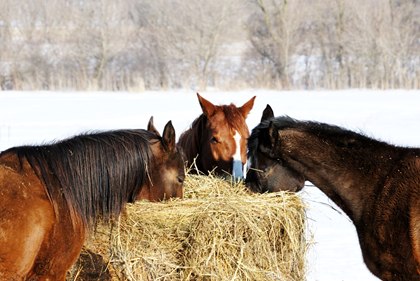Spring is finally here and horse owners everywhere will breathe a sigh of relief as the warmer weather returns to rescue the overgrazed mud-filled paddocks. Of course the arrival of British summer doesn’t necessarily herald the end of stabling for horses this season, and in fact the unwelcome return of flies and midges can force our irritated equines to seek shelter indoors.
Regardless of whether they are stabled or turned out all year round, hay is an important aspect of any equine’s diet. All horses require forage, and some more than others. As spring and summer take hold, the lush spring grass can force laminitic ponies indoors in order to restrict their grazing, but they will still require roughage as part of their diet, which is where hay comes in. Furthermore, the sun scorched paddocks may fail to satisfy a hungry herd at a busy livery yard, therefore it may be necessary to supplement grazing with a few bales of hay in high summer.
Unless you harvest your own, which can be a pricey process in itself, hay can prove to be an expensive commodity in the equestrian world. Good quality hay prices have soared in recent years as cash strapped farmers have been forced to increase the pounds per bale in order to recoup losses elsewhere. So how can we conserve hay? There is no doubt that it is one dietary requirement that our horses cannot do without, so here are our top five tips to help make your hay last longer.
- Use a hay net
Simply throwing a press or two of hay over the stable door may seem like a quick fix when you are in a rush of an evening, however a large proportion of the hay will likely get lost on the floor. Horses can be incredibly fussy eaters who will not look at hay that is mixed in with their bedding, so if your horse is notorious for churning up his bed, the likelihood is he will church up half of his hay with it. Avoid waste by filling small holed hay nets up a day or two in advance so you can quickly secure one when you are in a rush.
- Use a hay feeder
For the same reason as above, it is well worth investing in a purpose built hay feeder for your paddocks, especially if you have several horses grazing there. A feeder keeps your hay off the floor, where it can become mixed up in the mud and blown across the field by the wind, plus a large circular design allows multiple horses to feed from both sides, preventing fights from breaking out. If you have separate hay supplies to others on your yard, try and feed your horse separately to avoid him being chased away by dominant horses, therefore wasting your forage.
- Rotate your grazing
If you look after your grazing, you will require less hay to supplement your horse’s diet. Therefore, by carefully rotating and resting your grazing, you will maintain greener grass with less weeds and parasitic risk for all the horses in occupation.
- Invest in the best
Good quality hay can be fed dry as it has less dust and spores, plus it will keep longer than cheaper hay cuts that need soaking as soaked hay cannot be kept. Quality hay that is not soaked or steamed retains the nutrients and calories your horse needs, such as calcium, phosphorus, magnesium, potassium and protein, therefore invest in the best for your horse’s health and well-being.
- Safe storage
How you store your hay has a direct correlation to how long it will last. The ideal way to store hay is in large indoor barns where the hay will be protected from the elements, however if you cannot fit all your supplies indoors then make sure that any bales stored outside are covered if possible and are used first, as these will perish long before the indoor supplies do.

